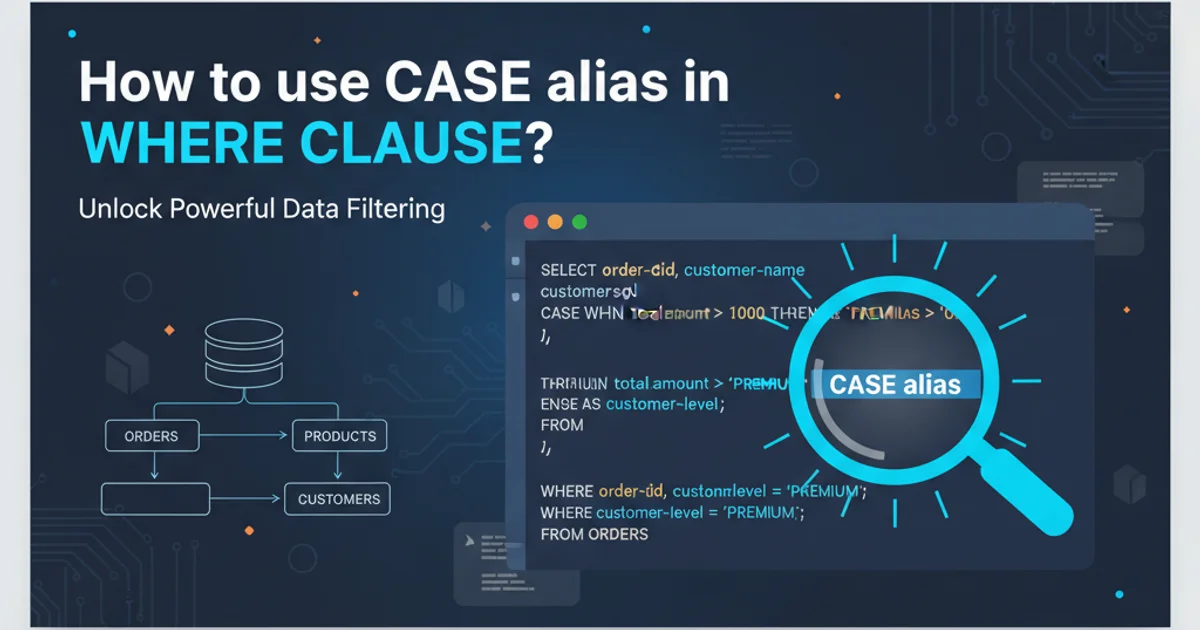How to use CASE alias in WHERE CLAUSE?
Categories:
Can You Use a CASE Alias in a WHERE Clause in T-SQL?

Explore the limitations and workarounds for using CASE expressions and their aliases directly within the WHERE clause in T-SQL, providing practical solutions for common scenarios.
A common question among T-SQL developers is whether an alias defined using a CASE expression in the SELECT clause can be directly referenced in the WHERE clause. While it seems intuitive, SQL's logical processing order prevents this direct usage. This article will explain why this limitation exists and provide several effective strategies to achieve the desired filtering logic.
Understanding SQL's Logical Processing Order
To grasp why a CASE alias cannot be used directly in the WHERE clause, it's crucial to understand the logical order in which SQL queries are processed. This order is not necessarily the order in which you write the clauses. The typical logical processing order for a SELECT statement is as follows:
FROMclause: Determines the tables involved and performs joins.WHEREclause: Filters rows based on specified conditions.GROUP BYclause: Groups rows that have the same values in specified columns.HAVINGclause: Filters groups based on specified conditions.SELECTclause: Evaluates expressions, includingCASEexpressions, and defines aliases.ORDER BYclause: Sorts the final result set.
flowchart TD
A[Start Query] --> B[FROM (Table/Joins)]
B --> C[WHERE (Row Filtering)]
C --> D[GROUP BY (Grouping Rows)]
D --> E[HAVING (Group Filtering)]
E --> F[SELECT (Column Selection/Aliases)]
F --> G[DISTINCT (Remove Duplicates)]
G --> H[ORDER BY (Sorting)]
H --> I[TOP/OFFSET (Limit Results)]
I --> J[End Query]Logical Processing Order of a SQL SELECT Statement
As you can see from the diagram, the SELECT clause, where aliases are defined, is processed after the WHERE clause. This means that when the WHERE clause is evaluated, the alias from the CASE expression simply doesn't exist yet in the logical scope of the query. Attempting to use it will result in an "Invalid column name" error.
Workaround 1: Repeating the CASE Expression
The most straightforward workaround is to simply repeat the entire CASE expression directly within the WHERE clause. While this can make the query longer and potentially less readable if the CASE expression is complex, it's often the quickest solution.
SELECT
ProductName,
ListPrice,
CASE
WHEN ListPrice > 100 THEN 'Expensive'
WHEN ListPrice BETWEEN 50 AND 100 THEN 'Moderate'
ELSE 'Cheap'
END AS PriceCategory
FROM
Production.Product
WHERE
CASE
WHEN ListPrice > 100 THEN 'Expensive'
WHEN ListPrice BETWEEN 50 AND 100 THEN 'Moderate'
ELSE 'Cheap'
END = 'Expensive';
Repeating the CASE expression in the WHERE clause.
CASE expression works, be mindful of its complexity. For very long or resource-intensive CASE statements, repeating it might lead to less efficient query plans, though modern SQL optimizers are often smart enough to handle this efficiently.Workaround 2: Using a Common Table Expression (CTE) or Subquery
A more elegant and often preferred solution for complex CASE expressions is to use a Common Table Expression (CTE) or a subquery. This allows you to define the CASE expression and its alias in an inner query (or CTE) and then reference that alias in the outer query's WHERE clause.
WITH ProductCategories AS (
SELECT
ProductName,
ListPrice,
CASE
WHEN ListPrice > 100 THEN 'Expensive'
WHEN ListPrice BETWEEN 50 AND 100 THEN 'Moderate'
ELSE 'Cheap'
END AS PriceCategory
FROM
Production.Product
)
SELECT
ProductName,
ListPrice,
PriceCategory
FROM
ProductCategories
WHERE
PriceCategory = 'Expensive';
Using a CTE to define and filter by a CASE alias.
The same logic applies to a subquery:
SELECT
ProductName,
ListPrice,
PriceCategory
FROM
(
SELECT
ProductName,
ListPrice,
CASE
WHEN ListPrice > 100 THEN 'Expensive'
WHEN ListPrice BETWEEN 50 AND 100 THEN 'Moderate'
ELSE 'Cheap'
END AS PriceCategory
FROM
Production.Product
) AS SubQueryAlias
WHERE
PriceCategory = 'Expensive';
Using a subquery to define and filter by a CASE alias.
Workaround 3: Using a CROSS APPLY (for more complex scenarios)
For scenarios where the CASE logic might be more complex or you need to generate multiple derived columns, CROSS APPLY can be a powerful alternative. It effectively creates a derived table for each row from the left table expression, allowing you to define and then filter on the derived columns.
SELECT
p.ProductName,
p.ListPrice,
pc.PriceCategory
FROM
Production.Product AS p
CROSS APPLY
(
SELECT
CASE
WHEN p.ListPrice > 100 THEN 'Expensive'
WHEN p.ListPrice BETWEEN 50 AND 100 THEN 'Moderate'
ELSE 'Cheap'
END AS PriceCategory
) AS pc
WHERE
pc.PriceCategory = 'Expensive';
Using CROSS APPLY to define and filter by a CASE alias.
CROSS APPLY is flexible, it might introduce a slight performance overhead compared to a simple CTE for very basic CASE expressions. Always test performance with your specific data and query patterns.